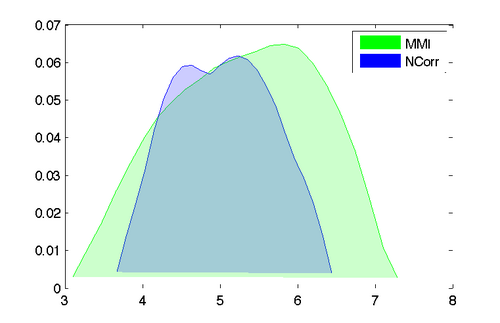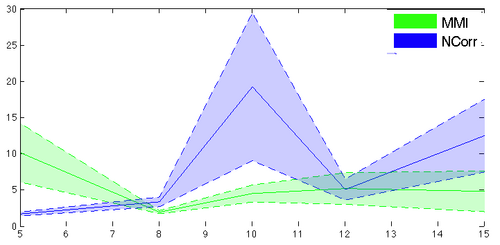Difference between revisions of "Projects:RegistrationDocumentation:ParameterTesting"
From NAMIC Wiki
| Line 16: | Line 16: | ||
*This self-validation scheme avoids recruiting an expert reader to determine ~ 3-5 anatomical landmarks on each unregistered image pair (time constraint). Also we can cover a wider range of misalignment and sensitivity by controlling the input Xform. It also facilitates batch processing. | *This self-validation scheme avoids recruiting an expert reader to determine ~ 3-5 anatomical landmarks on each unregistered image pair (time constraint). Also we can cover a wider range of misalignment and sensitivity by controlling the input Xform. It also facilitates batch processing. | ||
| − | [[Image:SRegTest_FLAIR-T1_LRRot15.png|left|500px|360 Level | + | [[Image:SRegTest_FLAIR-T1_LRRot15.png|left|500px|360 Level Self Validation Test]] |
| + | [[Image:RegistrationISMRM10_Disturb_12_hist.png|left|500px|RMS Histogram]] | ||
| + | [[Image:RegistrationISMRM10_RMS.png|left|500px|360 Level Sensitivity]] | ||
Revision as of 22:00, 27 October 2009
Home < Projects:RegistrationDocumentation:ParameterTestingBack to ARRA main page
Back to Registration main page
Back to Registration Use-case Inventory
ISMRM abstract 2010
- Title: MR-protocol Tailored Medical Image Registration
- Objective: Determine optimized sets of parameters for successful automated registration of MR-MR images within the 3DSlicer software. DOF, cost function, initialization and optimization strategy will differ because of the differences in image contrast and/or content. This work will present approaches and solutions for successful registration for a large set of combinations of MRI pairings. This is part of a concerted effort to build a Registration Case Library available to the medical imaging research community.
- Method:
- 1- choose 3-4 subjects/exams with 3-4 different contrast pairings: T1, T2, PD, FLAIR: ~12-16 images. We choose sets for which we have a good registration solution
- 2- disturb each pair by a known transform of varying rotational & translational misalignment
- 3- run registration for a set of parameter settings and save the result Xform, e.g. metric: NormCorr vs. MI , 2% vs 5% sampling, 50 vs. 100 iteration max
- 4- evaluate registration error as point distance and RMS. Plot error vs. initial misalignment (where does registration begin to fail), plot error vs. parameter settings (which setting works best for the toughest case)
- 5- run sensitivity analysis and report the best performing parameter set for each MR-MR combination
- 6-extension 1: add different voxel sizes, i.e. emulate 1,3,5mm slice thickness
- This self-validation scheme avoids recruiting an expert reader to determine ~ 3-5 anatomical landmarks on each unregistered image pair (time constraint). Also we can cover a wider range of misalignment and sensitivity by controlling the input Xform. It also facilitates batch processing.


